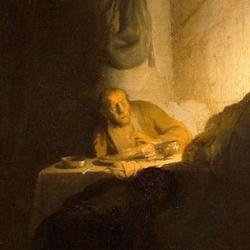In his Material Eucharist (30), David Grumett summarizes the “Homily on the Grain” from the Syrian poet Cyrillonas:
“Alluding to the incarnation and to Christ’s two natures,. he describes the grain falling into the earth and its kernel encased within a dual outer husk. This echoes the image that Jesus offers his disciples after his triumphal entry into Jerusalem, when he begins to prepare them for the events to come by comparing himself with a grain of wheat that falls into the earth and dies. Only in this way, Jesus explains in John’s Gospel, may the grain cease to be just a single grain and grow to bear much fruit. As the ear grows in the field it is pecked by birds, vermin, and insects, and is attacked by wind, rain, cold, frost, hail, thunder, and storms. Despite all these tribulations the grain itself assails no one, abiding in silence, living among humans, protecting them, and sustaining their eucharistic worship. Cyrillonas obviously alludes here to Christ, who during his ministry and trial was attacked yet abided in peace. The grain is raised up on its stem, opened, and cut down, as was Christ on the cross. In another text, Cyrillonas compares the threshing of the grain to Jesus’ scourging, and the bringing up of the grain into the windmill with Christ being lifted up on the cross.”
Quoting Cyrillonas: “It is by fire that it is cooked, and by its heat that it acquires its taste. And when all that is prescribed for it is accomplished, it departs to the table of the king. It satisfies the hungry with its sweetness, and gives strength to those who eat it, entirely like our Lord, who lays down his body on the holy altar: the people hungry for him eat him, and obtain the strength to trample death underfoot.”














